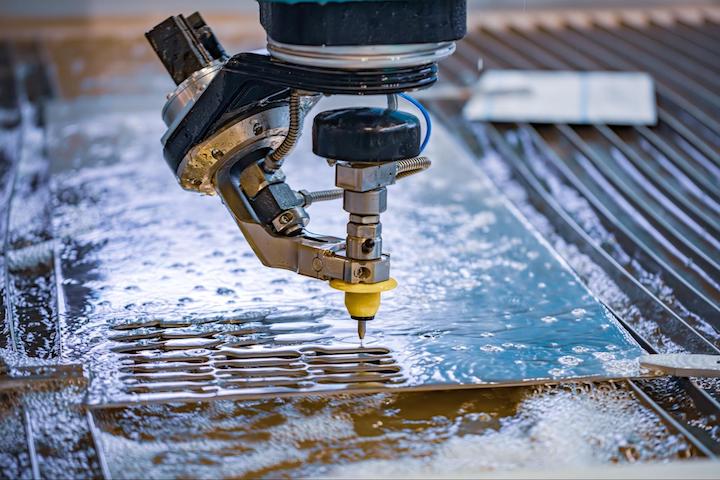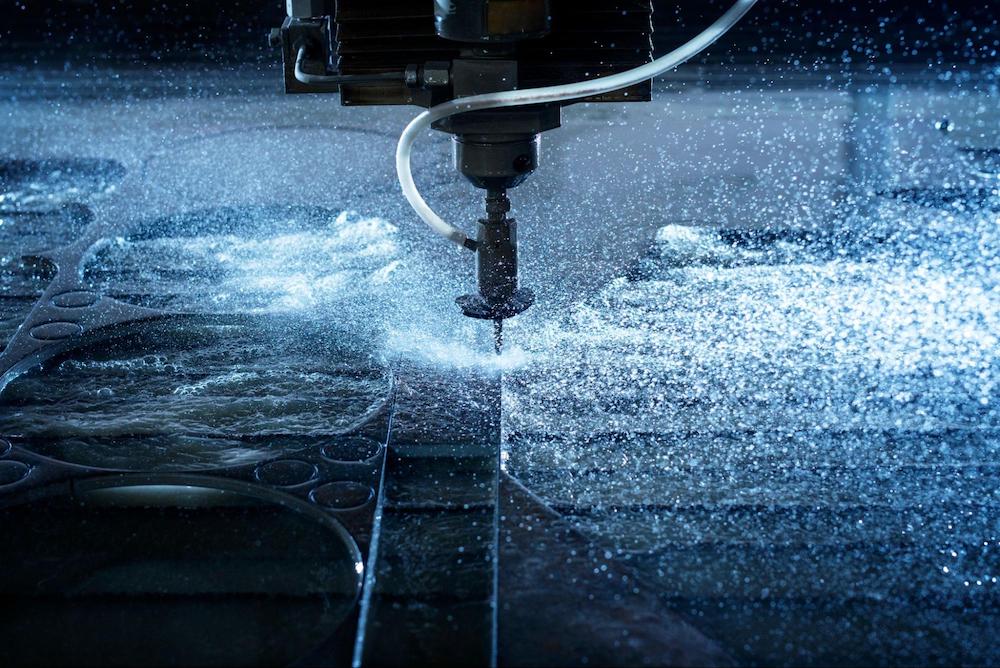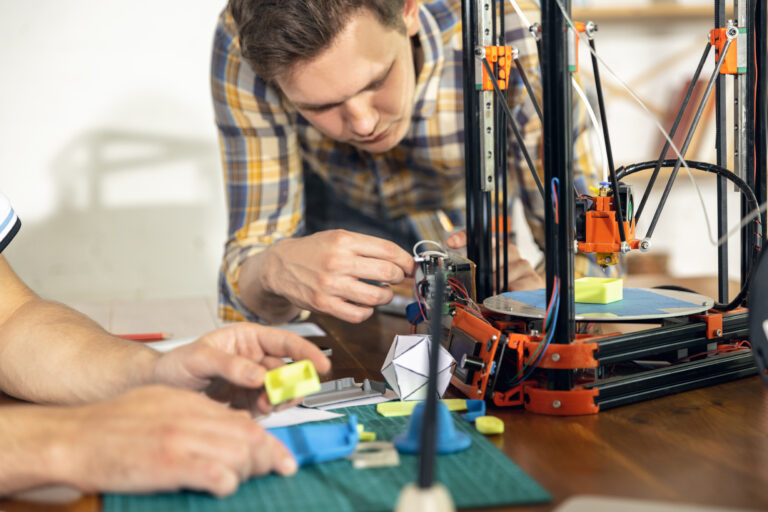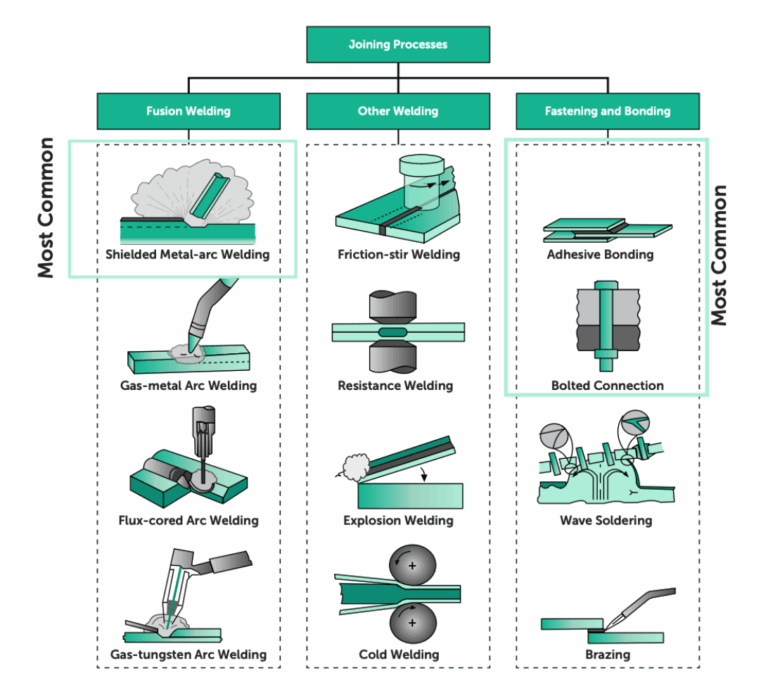Time to read: 5 min
Many processes may be utilized to cut sheet metal or other metal stock material. Among the most popular processes include pure and abrasive waterjet sheet metal cutting. Waterjet cutting offers g exact and proficient material-cutting capacities for industries such as aerospace. Waterjet cutting utilizes the force of a high-pressure stream of water or a combination of water and abrasive particles to make exact cuts. Two techniques are used for waterjet cutting: abrasive and pure. Read the article for a detailed overview of the two processes, including their qualities, benefits, and disadvantages, so that you can make informed decisions about your cutting requirements.

Abrasive Waterjet Cutting
Abrasive waterjet cutting is a highly effective method for cutting sheet metal. The process involves using a high-pressure stream of water mixed with abrasive particles, typically garnet, to cut through the metal. The abrasive nature of the waterjet allows for precise and accurate cuts, even in thick metal sheets. This method is beneficial for cutting complex shapes and designs, as it can easily maneuver around corners, complex geometries, and tight spaces. In addition to sheet metal, abrasive waterjet cutting can cut a wide range of materials, including ceramics, composites, stone, and glass. Its versatility makes it popular in many industries, including aerospace, automotive, and manufacturing.
Advantages of Abrasive Waterjet Sheet Metal Cutting
- Material Versatility: Adding abrasive particles enables abrasive waterjet cutting to be compatible with a more extensive range of materials than pure waterjet cutting. This makes it useful for enterprises utilizing a wide variety of materials.
- Thickness Capability: Abrasive waterjet cutting easily cuts thicker materials. The abrasive particles successfully erode the material, allowing for precise sheet metal cutting up to a few inches thick.
- Precision and Accuracy: While pure waterjet cutting is exact, the expansion of abrasive particles further improves the accuracy by helping facilitate cleaner material removal, guaranteeing particularly precise cuts.
Disadvantages of Abrasive Waterjet Sheet Metal Cutting
- Abrasive Consumption and Cleanup: Abrasive particles are often a recycled consumable, requiring more cleanup and processing, contrasted with pure waterjet cutting. This can prompt extra labor and time.
- Equipment Wear and Maintenance: Abrasive particles can prompt higher wear on hardware parts, requiring more constant support and substitution. This might increase maintenance costs over the long run.

Pure Waterjet Cutting
Pure waterjet cutting is a type of waterjet cutting that uses a high-pressure stream of water to cut through materials. Unlike abrasive waterjet cutting, which uses water and abrasive particles to cut through harder materials, pure waterjet cutting is ideal for softer materials such as elastic, foam, plastics, and certain metals. The process involves pressurizing water to extremely high levels and directing it through a small nozzle to create a focused stream of water that can precisely cut through the material. Pure waterjet cutting is a versatile and efficient method widely used in various industries, including aerospace, automotive, and manufacturing.
Advantages of Pure Waterjet Sheet Metal Cutting
- Minimal Material Change: Pure waterjet cutting doesn’t utilize abrasive particles, resulting in less erosion of the cut material. This is especially vital for applications where surface roughness is a priority.
- No Abrasive Utilization: As the name suggests, pure waterjet cutting doesn’t need abrasive particles, lowering consumable expenses.
- Reduced Wear and Tear on Equipment: The shortfall of abrasive particles is that the gear encounters less wear and requires less regular maintenance. This enables improved hardware life expectancy and reduces maintenance costs.
Disadvantages of Pure Waterjet Sheet Metal Cutting
- Limited Material Compatibility: Pure waterjet cutting isn’t reasonable for cutting harder or thicker materials. This limitation can confine its utilization to specific business uses and applications.
- Slower Cutting Paces for Thick Materials: When cutting thicker materials, pure waterjet cutting might be slower than abrasive waterjet cutting because the lack of abrasive particles means slower material removal. This can affect efficiency in applications that require quick cutting speeds.
Applications and Industry-Specific Considerations

Abrasive Waterjet Cutting Applications
Abrasive waterjet cutting is a versatile technology that is widely used in various industries. For example, it is commonly used in metal manufacturing to cut through metals of varying thicknesses and shapes. In the aerospace industry, it’s used to cut materials such as titanium, aluminum, and composites. In the automotive sector, it’s used to shape and cut auto parts made from metal or composites. Additionally, it is utilized in the construction industry to cut stone and tiles for various development and design applications.
Pure Waterjet Cutting Applications
Pure waterjet cutting is commonly employed in industries and applications where minimal alteration of materials is necessary. These include the cutting of food items such as fruits, vegetables, and meats in the food industry, precision cutting for dosage forms in the pharmaceutical industry, and the cutting of delicate materials for gasket production in the manufacturing of gaskets.
Choosing The Right Technique For Your Application
The choice between abrasive and pure waterjet cutting depends on a few basic variables:
Material Type and Thickness
Consider the type and thickness of the materials you plan to cut. Abrasive waterjet cutting succeeds with many materials and is incredibly useful with thicker substances. However, pure waterjet cutting is the most appropriate for softer materials.
Surface Finish Requirements
Determine whether the surface roughness of the cut material is a critical factor for your application. If a smooth surface completion is vital, pure waterjet cutting may be the better option.
Budgetary Considerations
Figure introductory speculation costs and long-haul functional expenses, including consumables and support. Pure waterjet, for the most part, has lower consumable expenses, yet abrasive waterjet may be more expense-conscious for specific applications.
Application-Specific Needs
Think about the particular prerequisites of your application. Does it require the adaptability of abrasive waterjet cutting, or is the accuracy and negligible material removal presented by pure waterjet cutting?
Consulting with Experts
If you’re trying to make an informed decision about waterjet cutting, seeking expert advice can be very helpful. They can offer insights based on their experience and expertise, helping you choose the cutting method that best suits your specific needs.
All in all, choosing between abrasive and pure waterjet cutting is a choice that is dependent on multiple variables. Abrasive waterjet cutting can cut a more significant amount of materials and thicker substances, making it valuable for ventures with assorted materials. Then again, pure waterjet cutting offers negligible material removal and lower consumable expenses, making it ideal for applications where surface roughness and cost are critical.
Finally, the choice should be made after carefully considering material type, thickness, surface roughness needs, budgetary constraints, and application-specific requirements. Talking with waterjet cutting specialists or specialist co-ops can give you important information to identify the technique that best suits your cutting requirements. At Fictiv, our passion is to enable product innovators to create. You can upload a part design for an instant quote or create a free account today.










